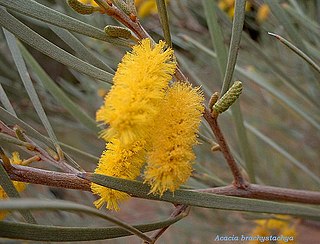
Acacia aneura, commonly known as mulga or true mulga, is a shrub or small tree native to arid outback areas of Australia. It is the dominant tree in the habitat to which it gives its name (mulga) that occurs across much of inland Australia. Specific regions have been designated the Western Australian mulga shrublands in Western Australia and Mulga Lands in Queensland.

Acacia brachystachya, commonly known as umbrella mulga, turpentine mulga or false bowgada, is a shrub in the family Fabaceae. The species occurs in mulga and heath communities on sandhills and rocky ridges in all mainland states of Australia, except Victoria.

Acacia, commonly known as the wattles or acacias, is a genus of about 1084 species of shrubs and trees in the subfamily Mimosoideae of the pea family Fabaceae. Initially, it comprised a group of plant species native to Africa, South America and Australasia, but is now reserved for species mainly from Australia, with others from New Guinea, Southeast Asia and the Indian Ocean. The genus name is Neo-Latin, borrowed from the Greek ἀκακία, a term used by Dioscorides for a preparation extracted from the leaves and fruit pods of Vachellia nilotica, the original type of the genus. In his Pinax (1623), Gaspard Bauhin mentioned the Greek ἀκακία from Dioscorides as the origin of the Latin name.
Acacia ayersiana var. latifolia is a plant that grows in arid areas of Australia.
Acacia aneura var. fuliginea is a perennial tree which is native to Western Australia.
Acacia aneura var. macrocarpa is a perennial shrub native to Australia. Commonly found in the Northwest Region of Australia.
Acacia aneura var. major is a perennial tree native to Australia.
Acacia aneura var. microcarpa is a perennial shrub or tree endemic to Australia, in the Northern Territory and Western Australia.
Acacia aneura var. pilbarana is a perennial shrub native to Western Australia.
Acacia aneura var. tenuis is a perennial tree native to Australia.
Western pebble-mound mouse or Ngadji is a burrowing and mound building rodent in the family Muridae. They occur in the Pilbara, a remote region in the northwest of Australia.

Jalmenus icilius, the Icilius blue or amethyst hairstreak, is a butterfly of the family Lycaenidae. It is found in all mainland states of Australia, throughout much of the subtropical areas of the inland, from the Selwyn Range and from Carnarvon to Kalgoorlie. It is generally common except in the south-eastern end of its range in central and western Victoria, where it is now very scarce.
Yeelirrie is an East Murchison pastoral lease or sheep station on state Crown land, located approximately 80 kilometres (50 mi) south west of Wiluna, in the Mid West region of Western Australia. The nearest population centre to Yeelirrie homestead is Mount Keith Mine village, 45 kilometres (28 mi) to the east. The regional centre is Meekatharra, located 180 kilometres (112 mi) to the west.

Nacaduba biocellata, the double-spotted line blue, is a butterfly of the family Lycaenidae. It is found in Australia, Singapore, the New Hebrides, Sumba and Bali.

Acacia aptaneura, commonly known as slender mulga, is a shrub belonging to the genus Acacia and the subgenus Juliflorae. It is native to central and western parts of Australia.

Acacia fuscaneura, commonly known as sooty wattle, is a tree belonging to the genus Acacia and the subgenus Juliflorae. It is native to arid areas of central Australia.

Acacia paraneura, commonly known as weeping mulga, is a tree or shrub belonging to the genus Acacia and the subgenus Juliflorae. It is native to arid regions of Australia. The Indigenous Kurrama peoples know the tree as warlun.

Acacia ramulosa, commonly known as horse mulga or bowgada wattle, is a shrub belonging to the genus Acacia and the subgenus Juliflorae endemic to arid areas of Australia.
Advenathrips is a genus of thrips in the family Phlaeothripidae, first described by Morris, Mound and Sdhwarz in 2000.








